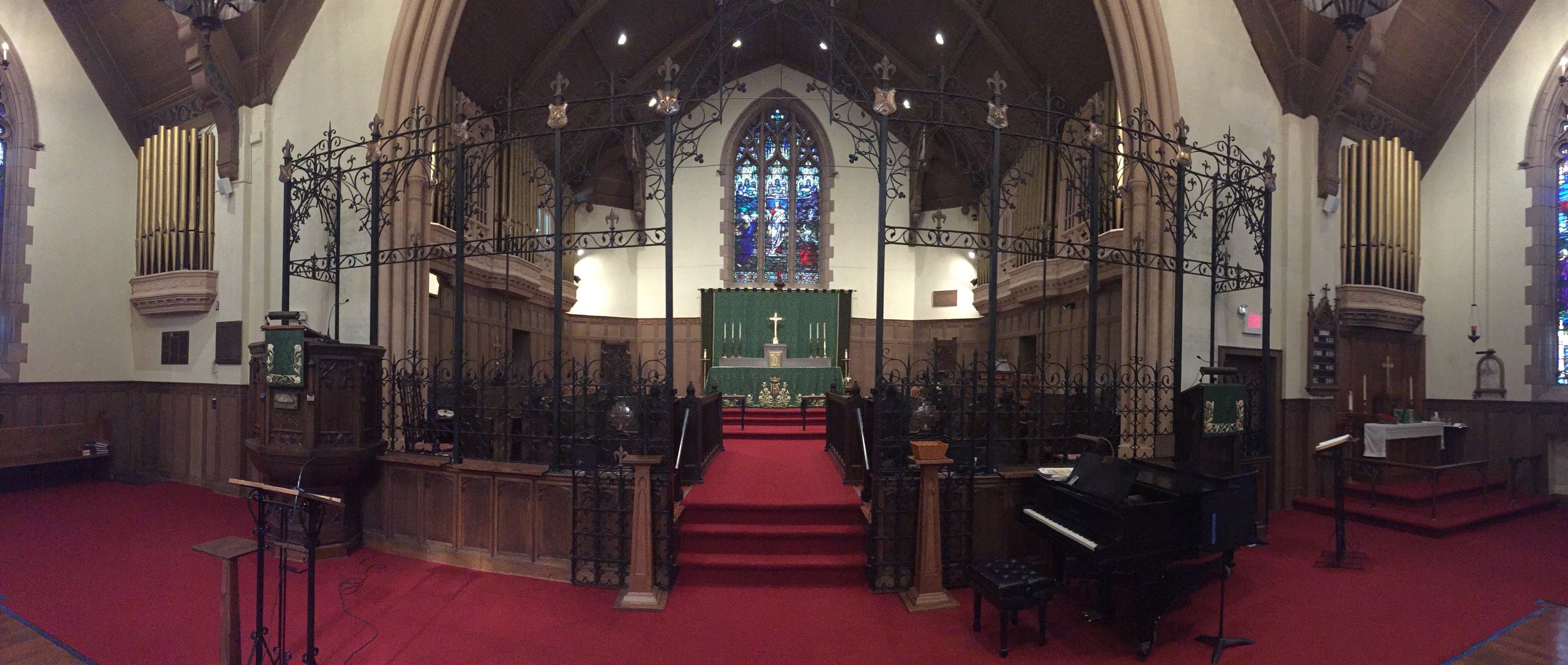St. Paul’s Episcopal Church
Bellingham, Washington, 1991
INTRODUCTION: This new organ is a continuation of a series of projects that started in 1934 and culminating with the current instrument, completed in 1992. The first organ was built by the EM Skinner Organ Company in 1913 as Opus 217 for the Alaska Theater in Seattle, WA. It was relocated to St. Paul’s by Balcom & Vaughan in 1931, as is. Balcom & Vaughan Pipe Organs provided a new 2M console along with tonal additions that included Principal stops to lead and support congregational singing. Prior to the installation of Opus 7, the organ chambers were remodeled to accommodate the instrument’s larger size and provide for safe and efficient access for both tuning and repair.
CASEWORK/FAÇADE: The existing façade pipes that are located on both sides of the Chancel and Transept are non speaking, an original design concept. No attempt was made to change this layout. In the new layout, the Swell chamber is in the front of the chamber and speaks into both the Chancel and Transept. The back section of the chamber includes the Great (directly behind the façade) with the Choir directly behind that (under expression). The Pedal windchests sit to the right of the Great and the lower pitched pipes directly behind the Choir.
WINDCHESTS: The existing Skinner windchests (16’ Open Wood and 16’ Subbass in the Pedal) were rebuilt. All new windchests were added; the main windchests are of slider/pallet design and unit windchests of direct valve design.
CONSOLE: A new console was built that included rocker tab stop action units by Harris Precision Products and a new switching system from Solid State Organ Systems.
PIPEWORK: All of the new metal pipes were hand crafted Jacques Stinkens of Zeist, Holland. Complete Principal choruses were added, including the Pedal. Some notable stops include the Choir mounted Cornet III, Swell 8’ Trompette (heroic in nature) and the Pedal 32’ Fagott. All of the existing Skinner and Balcom & Vaughan pipework was rescaled and revoiced to match the new sounds of the organ.
DESIGN: The organ is used heavily for both morning and afternoon worship services as well as an active concert program.


Great Organ
16’ Violone
8’ Principal
8’ Flute Harmonique
8’ Rohrflute
8’ Violone
4’ Octave
4’ Koppel Flute
2 2/3’ Quinte
2’ Super Octave
2’ Block Flute
1 3/5’ Seventeenth
1 1/3’ Mixture IV-VI
16’ Fagott
8’ Trompete
4’ Clarion
Tremulant
Chimes
Swell Organ
16’ Lieblich Gedeckt
8’ Principal
8’ Gedeckt
8’ Salicional
8’ Voix Celeste
4’ Octave
4’ Flute Octiviante
2 2/3’ Nasard
2’ Octavin
1 3/5’ Tierce
1 1/3’ Plein Jeu IV
16’ Bombarde
8’ Trompette
8’ Oboe
8’ Vox Humana
Tremulant
Choir Organ
8’ Geigen
8’ Dopple Flute
8’ Gedackt
8’ Gemshorn
8’ Gemshorn Celeste
4’ Principal
4’ Spill Flute
2 2/3’ Cornet III
2’ Octave
1 1/3’ Quinte
2/3’ Cymbel IV
16’ Dulzian
8’ Clarinet
Tremulant
Pedal Organ
32’ Resultant
16’ Principal Bass
16’ Subbass
16’ Bourdon
16’ Violone
8’ Octavebass
8’ Gedecktbass
8’ Violone
4’ Choralbass
4’ Flotenbass
2 2/3’ Mixture IV
32’ Contra Fagott
16’ Bombarde
16’ Fagott
8’ Trompette
4’ Clarion
4’ Fagott
Stops: 47
Ranks:64
Pipes: 3,144